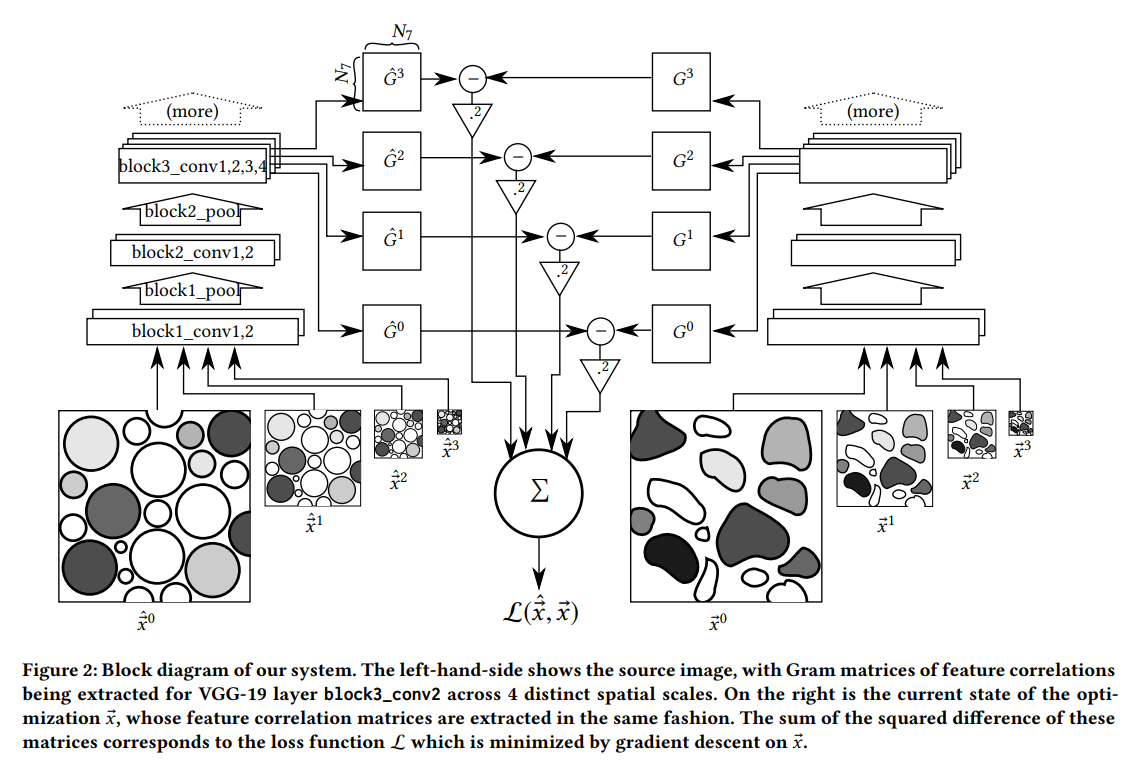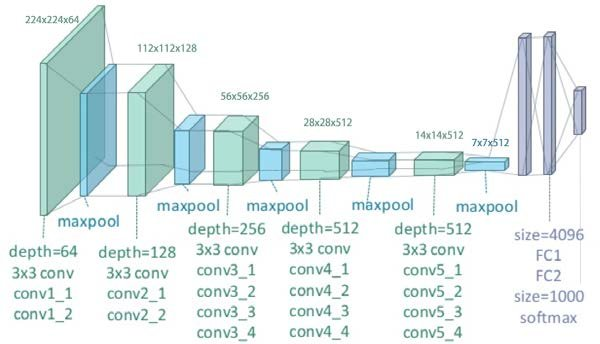High-Resolution Multi-Scale Neural Texture Synthesis (Mert Toka Presentation)
Xavier Snelgrove paper: (paper)
Texture synthesis:
"Texture synthesis is the process of algorithmically constructing a large digital image from a small digital sample image by taking advantage of its structural content." (source)
- Preserves image features
- Does not analyze semantically
Images:

Arguments
| Long Arg | Short Arg | Usage | Default | Short Desc. |
|---|---|---|---|---|
| --source | -s | -s SOURCE [SOURCE ... ] | None | List of file to use as source textures |
| --output-width --output-height | -ow, -oh | -ow NUMBER, -oh NUMBER | 512, 512 | Output width and height |
| --octaves | -o | -o NUMBER | 4 | Number of octaves |
| --layers | -l | -l LAYERS [LAYERS ... ] | [2,7] | Which layers to match gram matrices on |
| --join-mode | -j | -j {average, max} | average | How to combine gram matrices when multiple sources given |
| --mul | --mul NUMBER | 1.0 | Multiply target grams by this amount | |
| --seed | --seed {random, symmetric} | random | How to seed the optimization | |
| --source-scale | -ss | -ss NUMBER | None | How much to scale the source image by |
| --source-width | -sw | -sw NUMBER | None | Scale source to this width. Mutually exclusive with source-scale |
| --padding-mode | -p | -p {valid, same} | valid | What boundary condition to use for convolutions |
| --tol | --tol NUMBER | 1e-09 | Gradient scale at which to terminate optimization | |
| --data-dir | -d | -d DIRECTORY | "model_data" | Where to find the VGG weight files |
| --output-dir | --output-dir DIRECTORY | "outputs" | Where to save the generated outputs | |
| --max-iter | -m | -m NUMBER | 500 | Maximum iterations for the L-BFGS-B optimizer |
| --output-prefix | -op | -op PREFIX | "out" | Prefix to append to output directory |
| --save-every | -n | -n NUMBER | 10 | Save an in-progress optimization image every SAVE_EVERY iterations |
| --count | -c | -c NUMBER | 1 | How many images to generate simultaneously |
| --if-weight | --if-weight NUMBER | 1.0 | Inter-frame loss weight | |
| --if-shift | --if-shift NUMBER | 5.0 | How many pixel-shift should inter-frame loss approximate? | |
| --if-order | --if-order NUMBER | 2.0 | How many frames should we 'tie' together? |
Details:

Tensorflow: Library that abstracts the details of common operations performed in machine learning
Keras: Python interface for Tensorflow
Gram matrices: Given a set of of vectors, the Gram matrix is the matrix of all possible inner products of . [ ]
- holds correlations of feature maps stored in the hidden layers
- powerful representation of the texture
- synthesize new images whose Gram matrix is close to that of an example image via gradient descent
ImageNet: Image database that has an average of 500 images per label
VGG architectures: Pre-trained CNNs on ImageNet dataset. Keras now includes VGG-16 and VGG-19. VGG-19 network is 19 layers deep (16 convolutional + 3 fully connected) and can classify images into 1000 object categories.

Gaussian Pyramid: An image processing technique that iteratively blurs and down-samples the image.

Download & Install:
Tested on Ubuntu 18.04 with Python 3.6.12.
- possibly will run the same on MacOS
git clone https://github.com/wxs/subjective-functions.git
cd subjective-functions
pip3 install Pillow
pip3 install scipy==1.5.2
pip3 install numpy==1.19.2
pip3 install --user --upgrade tensorflow-gpu
pip3 install --user --upgrade tensorboard
pip3 install keras==2.3.1
pip3 install --user --upgrade tensorflow-gpu==1.14.0
pip3 install h5py==2.10.0
KERAS_BACKEND=tensorflow python3 synthesize.py -s bark.jpg
# If you would like to use different arguments, simply append them at
# the end of the above line. e.g.:
KERAS_BACKEND=tensorflow python3 synthesize.py -s bark.jpg -o 1 -l 3 5 -mul 1.5
# Sequencing multiple runs back to back (put a semi column (;) in between different lines). e.g.:
KERAS_BACKEND=tensorflow python3 synthesize.py -s bark.jpg -l 3 8 -mul 1.5 ; KERAS_BACKEND=tensorflow python3 synthesize.py -s bark.jpg -o 2 -l 2 5 ;
Possible roadblock:
- Modify h5py library in /home/<USERNAME>/.local/lib/python3.6/site-packages/keras/engine/saving.py
Line 273:
model_config = json.loads(model_config.decode('utf-8'))
to
model_config = json.loads(model_config)#.decode('utf-8'))
Line 278:
original_keras_version = model_weights_group['keras_version'].decode('utf8')
to
original_keras_version = model_weights_group['keras_version']#.decode('utf8')
Line 282:
original_backend = model_weights_group['backend'].decode('utf8')
to
original_backend = model_weights_group['backend']#.decode('utf8')